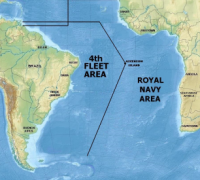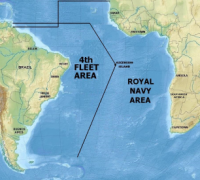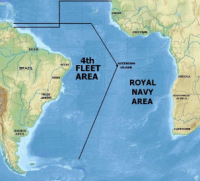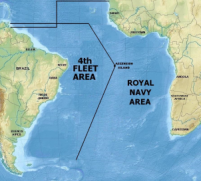U S NAVY 4th FLEET AT RECIFE - SHIP INDEX ATF ATR AV AVD AVP
4)AV 5 ALBERMALE
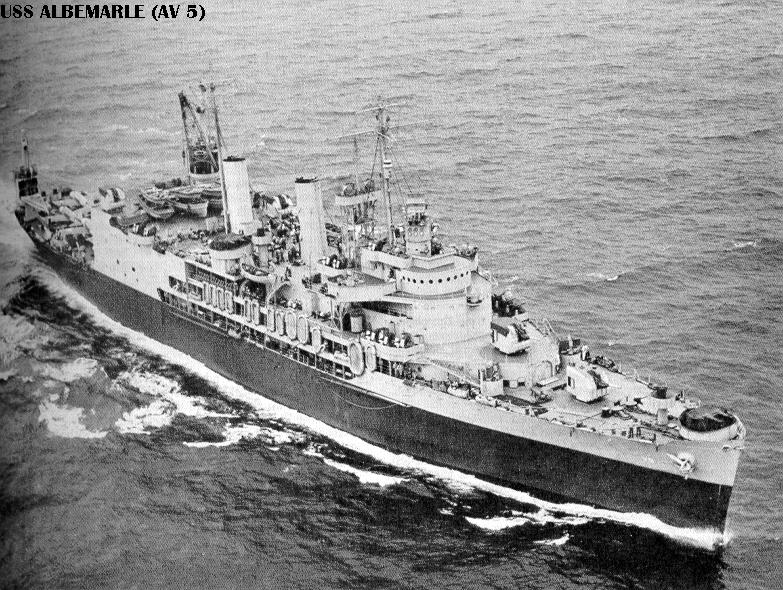
Photo. http://www.navsource.org/archives/09/41/09410503.jpg
Specifications:
Displacement 8,671 t.
Length 527' 4".
Beam 69' 3".
Draft 21' 11".
Speed 20 kts.
Complement (AV-5) 1,195
(ARVH-1) 128 civilian, 308 Army Technicians.
Armament: (AV) As Built, four single 5"/38 dual purpose gun mounts, four quad 40mm AA gun mounts, (AV) Added during WWII, two dual 40mm AA gun mounts, twelve single 20mm AA gun mounts.
(ARVH) none.
Propulsion geared turbines, two shafts.
Upon completion of her refit, Albemarle got underway for Newport, on 5 May, 1942 and there, over the next few days, degaussed calibrated her direction finders, and loaded aircraft for transportation to Bermuda. Underway on 15 May with Mayo (DD-422) and Benson (DD-421) as escorts, the seaplane tender reached her destination on the 17th, unloaded the planes she had brought, and immediately set sail for Narragansett Bay.
Relieving Pocomoke (AV-9) in connection with aircraft torpedo and submarine familiarization training, on the 19th, Albemarle remained anchored in Narragansett Bay until 12 August, providing torpedo services for a succession of squadrons: VP-94, VP-34 VP-33 and Torpedo Squadron 4. Underway on 12 August and escorted by the destroyers Livermore (DD-430), Kearny (DD-432) and Rowan (DD-405), the submarine tender sailed for Norfolk. After her arrival there, Albemarle conducted gunnery exercises in the Chesapeake Bay operating area.
Shortly thereafter, escorted by Fletcher (DD-445) and O'Bannon (DD-450), Albemarle sailed for the Canal Zone on 5 September 1942. Damaging her starboard screw at Coco Solo, the seaplane tender was ordered drydocked for repairs; after transiting the Panama Canal for the first time on 15 September, she entered dry dock at Balboa on the following day. Upon completion of repairs, she transported Army troops and marines to Rio Hato Panama, for two days of joint Army-Navy maneuvers.
Over the next several months, Albemarle acted as fast transport of aeronautical material and men to naval air bases in the Caribbean and the Pacific coast of South America, as well as in the northern South Atlantic. During this time (September November 1942), she visited Salinas, Ecuador, the air base at Seymour Island, in the Galapagos Islands San Juan and Bermuda primarily operating out of Colon and Balboa and escorted by the seaplane tender Goldsborough (AVD-5).
Relieved on station by the seaplane tender Pocomoke (AV-9) Albemarle sailed from the Canal Zone on 13 November 1942, escorted by Goldsborough and the small seaplane tender Matagorda (AVP-22). Proceeding via San Juan, Trinidad and Bermuda, the seaplane tender reached Hampton Roads on 30 November having completed her longest sustained tour of duty outside the continental Limits of the United States.
Over the next seven months, Albemarle shuttled between Norfolk and Guantanamo Bay, Trinidad, San Juan, and Bermuda, on eight round- trip voyages. She varied this routine only slightly on the sixth and eighth of these, visiting Recife, Brazil for the first time (17 to 21 April 1943) on the sixth cruise and putting into the Canal Zone on the eighth. Her cargo included aviation gasoline and ammunition. Upon completion of that cycle of Operations she underwent repairs and alterations at the Boston Navy Yard between 15 June and 23 July 1943, departing on the latter date for Norfolk, whence she resumed her cargo-carrying and transport run to Trinidad, Recife, San Juan and Guantanamo Bay. On this voyage, her last on this run, she brought back 27 German prisoners of war survivors of a sunken U-boat.
Underway from Norfolk on 16 September 1943, Albemarle sailed for the British Isles, escorted by the destroyers Bulmer (DD-222) and Barker (DD-213). Proceeding via Argentia, the seaplane tender reached Swansea,Wales, with aeronautical cargo an passengers on 28 September, the men and freight she carried to support the newly inaugurated antisubmarine operations by patrol squadrons operating from the British Isles. Underway from Swansea on 4 October, she scraped a screw while leaving the harbor, and, after sailing via Argentia, reached Boston on 15 October. She was drydocked the following day, and the damaged propeHer was repaired. Albemarle returned thence to Norfolk via the Cape Cod Canal, arriving at Norfolk on 18 October.
Underway on 22 October as part of a task group formed around the escort carrier Croatan (CVE-25) and three destroyers Albemarle sailed for Casablanca. Routed via Bermuda, the group reached its destination on 3 November. After discharging her cargo and disembarking her passengers, the seaplane tender then sailed for the United States on 10 November with another convoy, this one larger and formed around Croatan and the light cruiser Philadelphia (CL-41), escorted by seven destroyers, and containing Matagorda and three transports.
Albemarle made a second cruise to Casablanca before the year 1943 was out, underway on 28 November and escorted by the destroyers Barry (DD-248) and Goff (DD-247), and arriving on 7 December. She sailed on the 13th for Reykjavik and reached that Icelandic port on the 19th. There she embarked men from VB 128 for transportation back to the United States, and proceeded out of Reykjavik on 22 December for Norfolk. Battling heavy seas on the return voyage (making only five knots on Christmas Day), Albemarle returned to NOB, Norfolk, on the last day of the year 1943.
Proceeding thence to Bayonne, N.J., on 4 January 1944, for upkeep and availability, Albelmarle returned to Norfolk on 17 January, and prepared for a voyage to San Juan. While outward-bound, however, on 18 January 1944, the seaplane tender fouled a buoy in a thick fog and put about for repairs. Drydocked on 20 January, Albemarle sailed again for her orig inal destination, San Juan, the following day.
Subsequently touching at Trinidad and Recife, and retracing her path calling at Trinidad and San Juan on the return leg of the passage, Albelmarle returned to Norfolk on 23 February for availability. She then steamed to Casablanca in company with the amphibious command ship Catoctin (AGC-5) and two destroyers and, among her passengers on the westward bound trip were 20 German U-boat sailors, prisoners of war. She arrived back at Norfolk on 1 April 1944.
After upkeep at NOB, Norfolk, Albelmarle proceeded up to the Naval Supply Depot at Bayonne, where she loaded aviation cargo, between 7 and 13 April. She then sailed, via Norfolk, to Guantanamo Bay, Trinidad, the Brazilian ports of Recife and Bahia, and San Juan, ultimately making arrival back at Norfolk on 27 May for voyage repairs and upkeep. Loading cargo at the end of that period, including 29 dive bombers, Albemarle again shaped a course for North African waters, the seaplane tender making arrival at Casablanca on 20 June. She proceeded thence to Avonmouth, England, where she loaded cargo and embarked passengers for return to the United States. Underway for Boston on 6 July, she reached her destination on the 13th.
Albemarle spent the next month undergoing a 30-day availability for repairs and alterations at the Boston Navy Yard. Emerging from the yard on 15 August, the seaplane tender proceeded to Bayonne, to load cargo. Sailing via Norfolk, the ship visited the familiar bases at San Juan, Trinidad, Recife and Guantanamo Bay before returning to NOB, Norfolk on 29 September.
After loading cargo at Bayonne (12 to 17 October), Albemarle headed south for the supply run to San Juan, Trinidad and Recife.
Outward-bound the voyage proved uneventful, however, while loading ammunition and cargo at San Juan for the return leg of the voyage, an electrical fire damaged the ship's main distribution board, putting Albemarle's lighting and ventilation systems out . of commission Underway for Hampton Roads on 22 November the seaplane tender reached Hampton Roads on the 25th, and moored at NOB, Norfolk, on the 26th to commence an availability.
Underway for Guantanamo Bay on the last day of 1944 Albemarle dropped anchor there on 4 January 1945. Reporting ; to Commander, Fleet Air Wing 11, for temporary duty, she boded Patrol Bombing Squadrons (VPB) 201 and 210 at "Gitmo" E until 17 January, when the seaplane tender sailed for Coco Solo arriving at her destination on the 19th. Thence she sailed for Trinidad where she tended VPB-213 from 1 to 11 February.
Shifting back to the Canal Zone soon thereafter Albemarle commenced tending operations for VPB-214 at Almirante Bay, Panama, on 18 February and remained engaged in that duty until Washington's Birthday. On 25 February, the ship was designated as flagship for Commander, Air Force Atlantic Fleet the day after she cleared Limon Bay for the Galapagos group.
There, Albemarle tended VPB-74 and VPB-209 from 27 February to 6 March, when the seaplane tender got underway to return to the Canal Zone. She steamed thence to Guantanamo Bay and Norfolk, arriving at the latter place on 17 March for an availability that lasted through mid- May 1945
Albemarle cleared Norfolk on 18 May for New York, laden with cargo, escorted by the destroyers Bernadou (DD-153) and Dallas. Two days later, the seaplane tender sailed for the British Isles in CU-71, a convoy formed around the venerable USAT George Washington. Albemarle's mission was to bring back to the United States those patrol squadrons whose task in the Atlantic had been completed with the end of the war in Europe and whose presence was required in the still-active Pacific theater. Ultimately, Albemarle reached her destination Avonmouth, on 30 May, and brought her passengers - men of Fleet Air Wing 7 - back to Norfolk on 14 June
Albemarle made a second voyage to Avonmouth sailing from Hampton Roads on Independence Day 1945 and reaching her destination on 13 July. There she embarked 772 sailors and soldiers the majority of the latter repatriated prisoners of war. Underway on the 17th, the seaplane tender arrived back at Norfolk on the 26th.
Entering the Norfolk Navy Yard on 28 July for repairs and alterations to fit her out for duty in the Pacific Albemarle was m the midst of this availability when the war in the Pacific ended in mid-August? 1945. The Japanese capitulation suspended the work; and, soon thereafter, the orders to the Pacific to tend seaplanes were cancelled.
DANFS DICTIONARY OF AMERICAN NAVAL FIGHTING SHIPS
US National Archives/Haze Gray & Underway
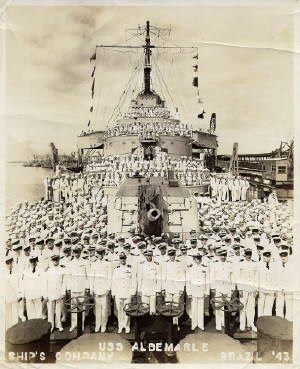
Ship's Company picture at Recife 1943

USS Albermale underway near Norfolk, VA., 7 September 1943. The ship is loaded with aviation cargo for transportation to the British Isles. A Martin PBM Mariner flying boat is shown on her fantail. US Navy photo # 80-G204836 from the collections of the US Navy History and Heritage Command.
